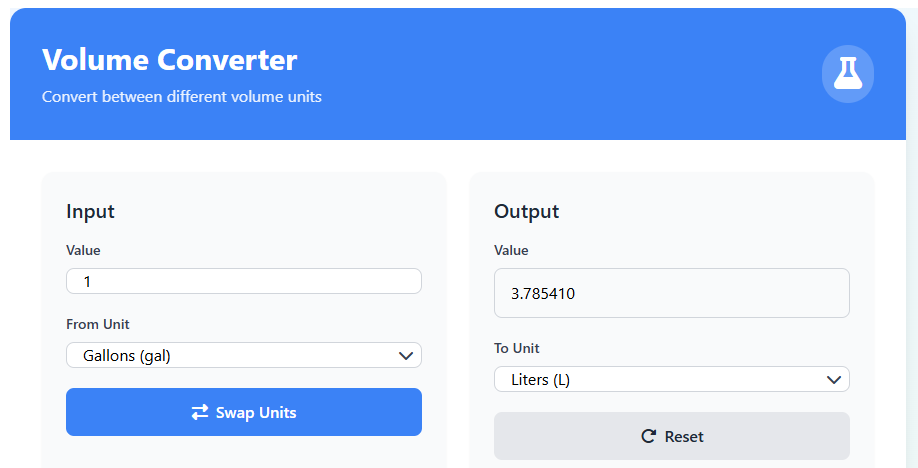Volume Converter
Convert between different volume units by Volume Converter
Input
Output
Common Conversions
| Unit | Liters | Milliliters | Gallons | Cubic Meters | Cubic Feet |
|---|
Volume Converter © 2023 | Made with
Volume Converter: Your Key to Accurate Liquid Measurements
Have you ever found a recipe that uses cups when you only have a milliliter measuring cup, or needed to convert gallons to liters for a science experiment? Understanding volume measurements can be confusing with different systems used worldwide, but fortunately, a Volume Converter makes it simple and precise. This helpful online tool translates volume units instantly, and therefore, it helps cooks, scientists, and DIY enthusiasts work with accurate measurements every time.
Volume Converter Explains Different Measurement Systems
First, let’s understand what volume conversion involves. Basically, volume measures how much space a liquid or substance occupies, but various countries use different units. For example, the US uses cups and gallons while most other countries use milliliters and liters. A Volume Converter knows all the mathematical relationships between these units. You simply input your volume amount, select its current unit, and choose your desired unit. Then, the calculator provides the converted value immediately. Consequently, you can follow any recipe or instruction regardless of its measurement system.
Volume Converter Helps in Many Practical Situations
Moreover, this tool isn’t just for professional chefs; it’s incredibly useful for many daily activities. A Volume Converter serves as a versatile helper for cooking, education, and home projects.
For Cooking and Baking
Recipes often use volume measurements from their country of origin. By using a Volume Converter, you can ensure accurate ingredient measurements, and therefore, your dishes will turn out perfectly every time.
For Science Experiments and Education
Science students frequently work with precise liquid measurements. A Volume Converter helps them convert between metric and imperial units, and consequently, they can conduct experiments with accurate measurements.
For DIY and Home Improvement
Furthermore, home projects often require mixing liquids in specific ratios. A Volume Converter helps determine exact amounts needed, and as a result, you can complete projects efficiently without wasting materials
Volume Converter Makes Unit Conversion Simple
So, how do you use this fantastic tool? It’s designed to be very user-friendly. First, you enter your volume number. Next, you select its current unit (like cups or liters). Then, you choose the unit you want to convert to. This tool processes the conversion instantly and displays the result. As a result, you get accurate conversions without manual calculations. In conclusion, understanding volume measurements is easier than ever, and the Volume Converter on Tooltura is the perfect, free tool to help you. Try it today to become a measurement conversion expert!

Frequently Asked Questions
Q1: What is an online volume converter and how does it work?
A: This is a digital tool that, first, allows you to input a volume measurement. Then, you select your current unit and target unit, and subsequently, it instantly calculates the converted volume using precise conversion formulas.
Q2: Why should I use a liters to gallons converter for fuel economy?
A: You should use a liters to gallons converter for fuel economy because different countries use different units; consequently, this tool helps you compare vehicle efficiency and, therefore, make informed decisions about fuel consumption.
Q3: Can a cups to milliliters converter help with baking?
A: Absolutely, a cups to milliliters converter is perfect for baking. It provides precise conversions for liquid ingredients, and then ensures your recipes turn out correctly, which ultimately creates better baking results.
(FAQs)
Q4: How does a fluid ounce to milliliter converter work for recipes?
A: A fluid ounce to milliliter converter works by first taking the volum in fluid ounces. Then, it multiplies by 29.5735 (the conversion factor), and subsequently, it provides the equivalent volume in milliliters for accurate recipe following.
Q5: Is a free volume converter accurate for scientific measurements?
A: Yes, a high-quality free volume converter is very accurate for most purposes because it uses standardized conversion rates. However, for critical scientific work, always verify with laboratory-grade measuring instruments.
Q6: What are the benefits of using a cooking measurement converter?
A: The benefits of a cooking measurement converter are significant; specifically, it handles all common kitchen units in one tool. As a result, cooks can easily follow international recipes and consequently expand their culinary repertoire.
Q7: How do I convert gallons to liters manually?
A: To convert gallons to liters manually, you first multiply the gallon amount by 3.78541 (the conversion factor). Then, you calculate the result, and subsequently, you get the volumes in liters, though using a converter is much faster and more accurate.